
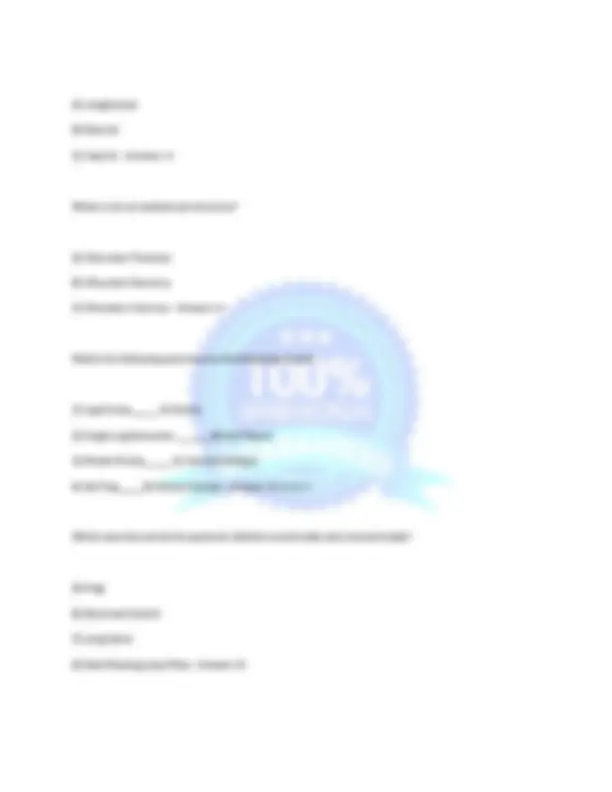

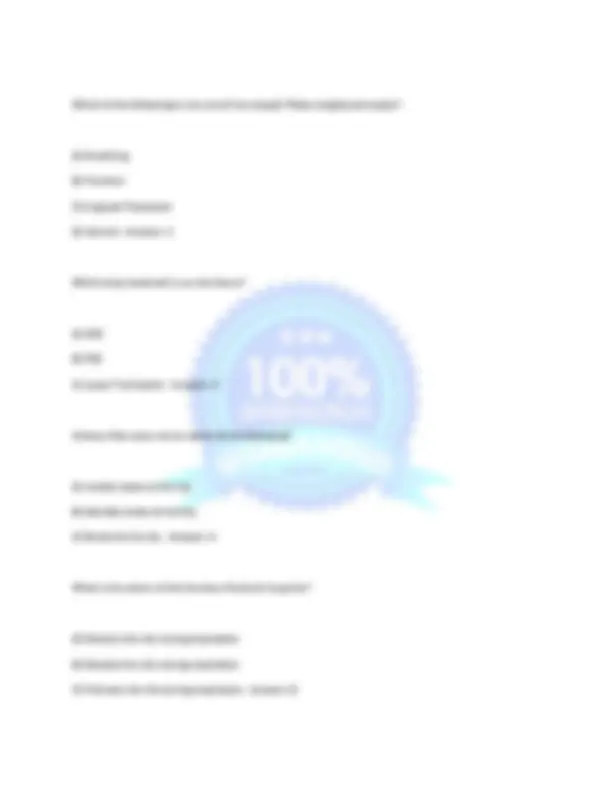
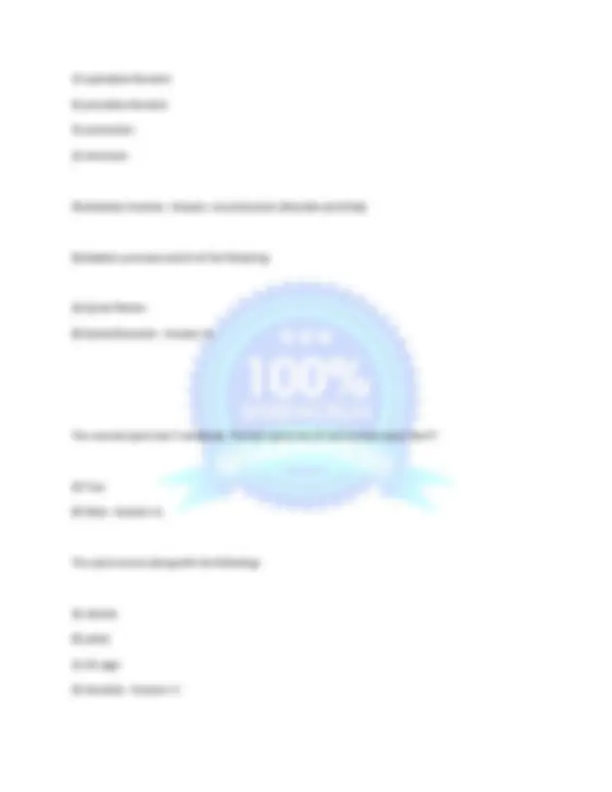
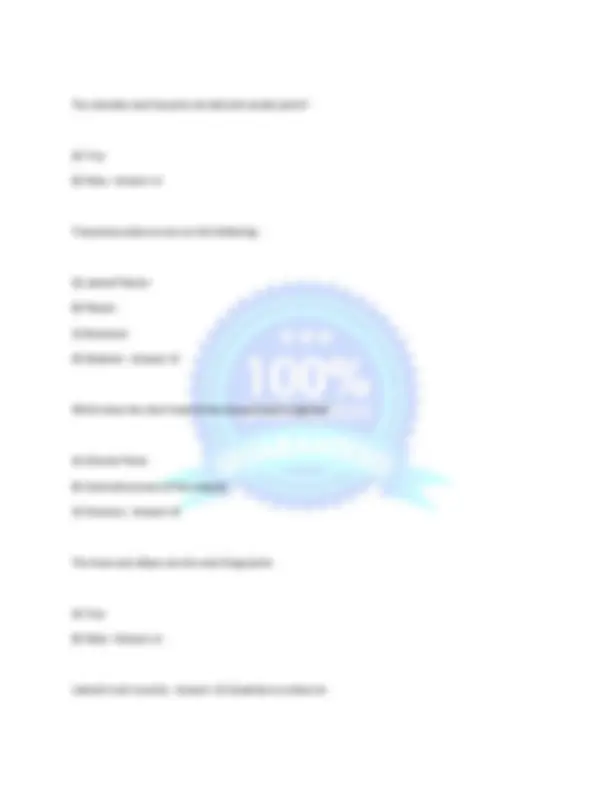
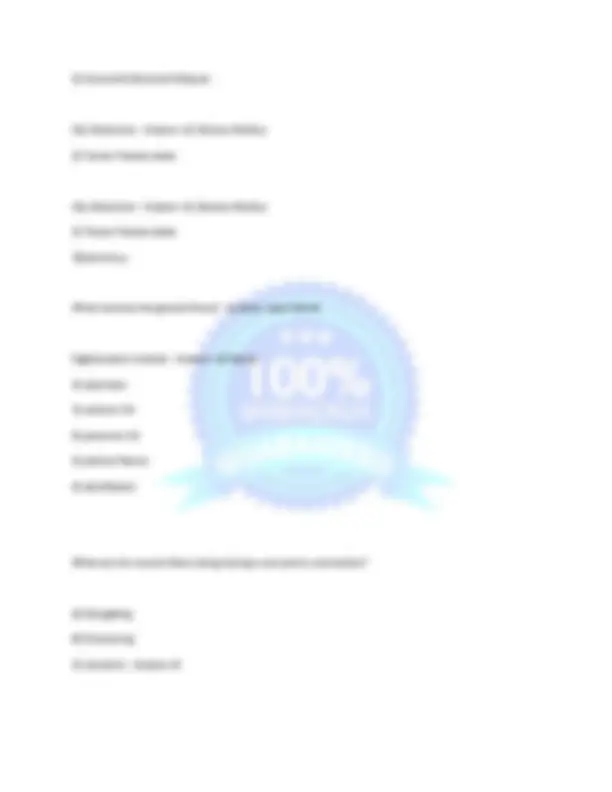
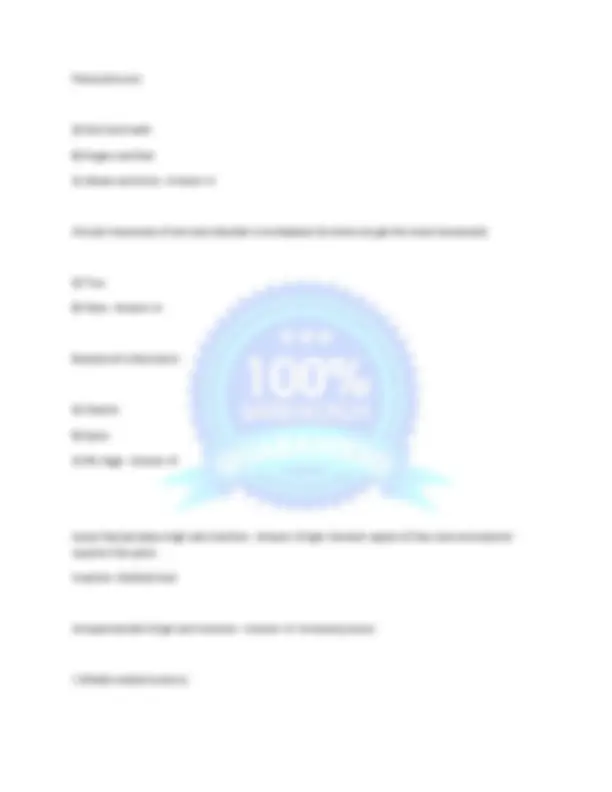
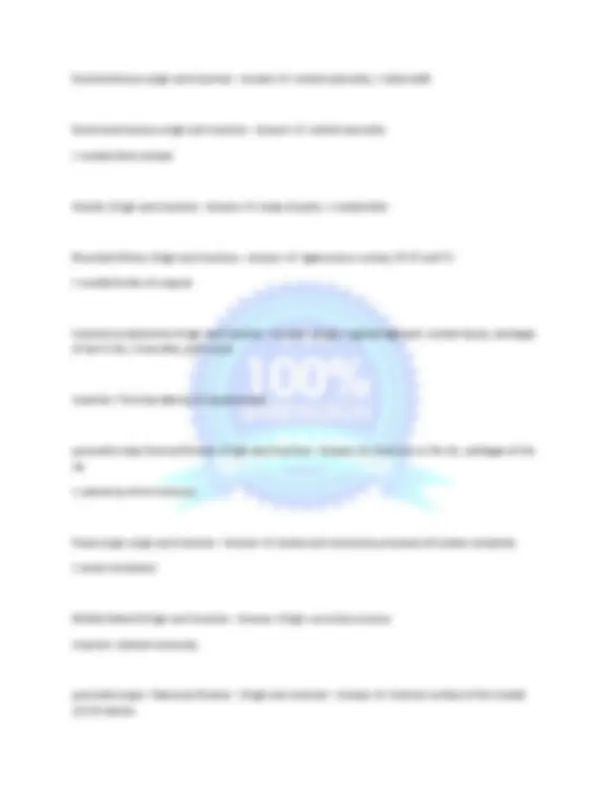
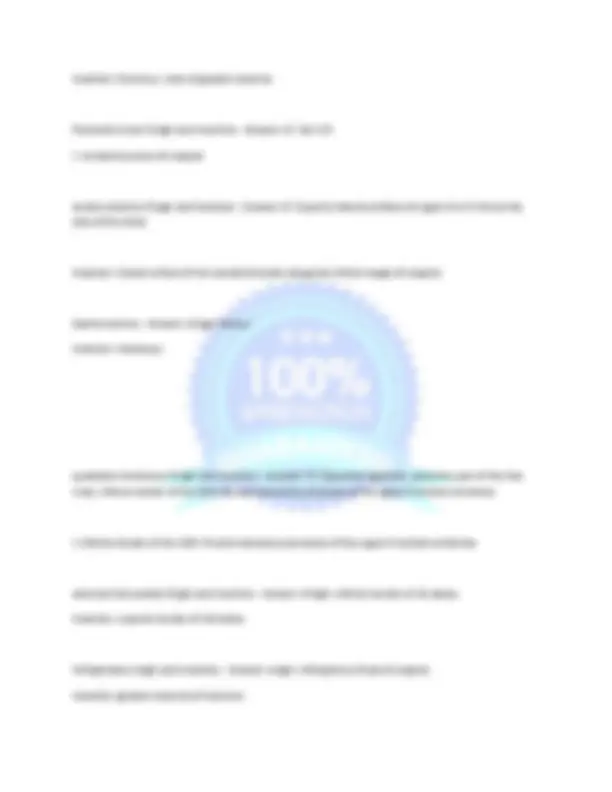
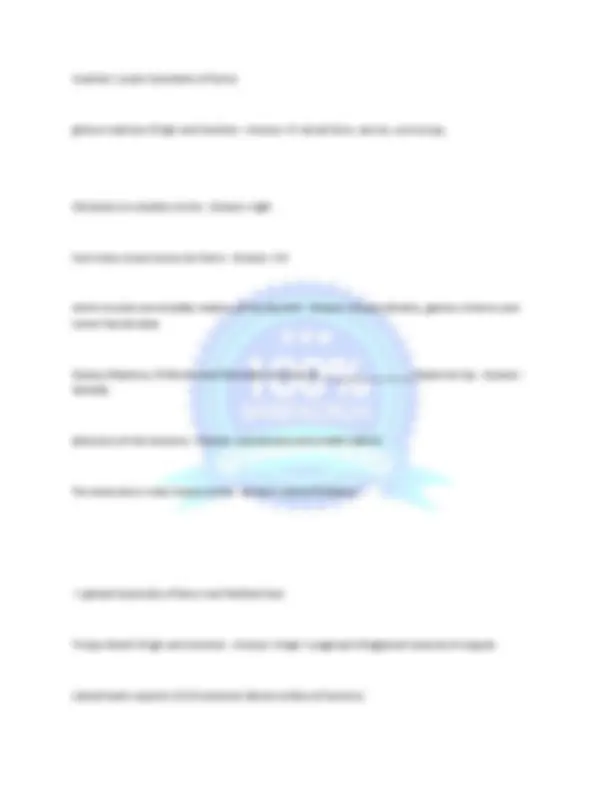
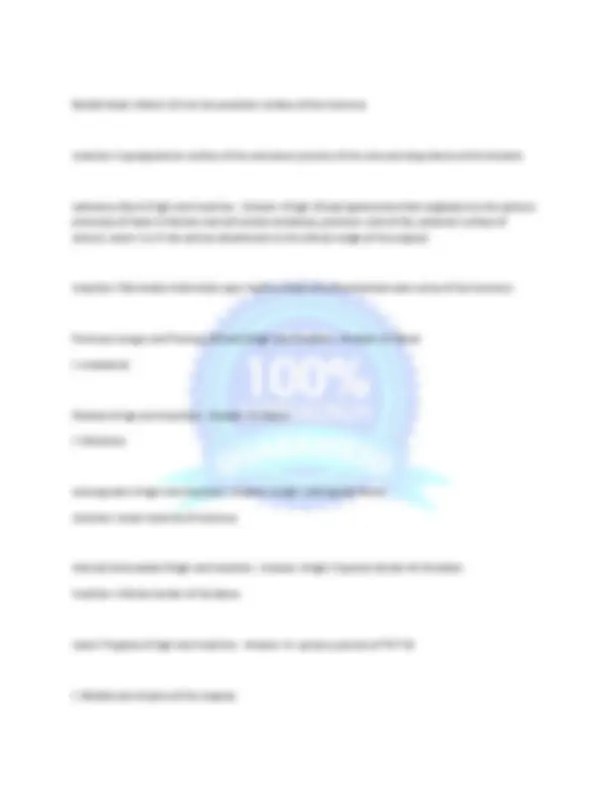
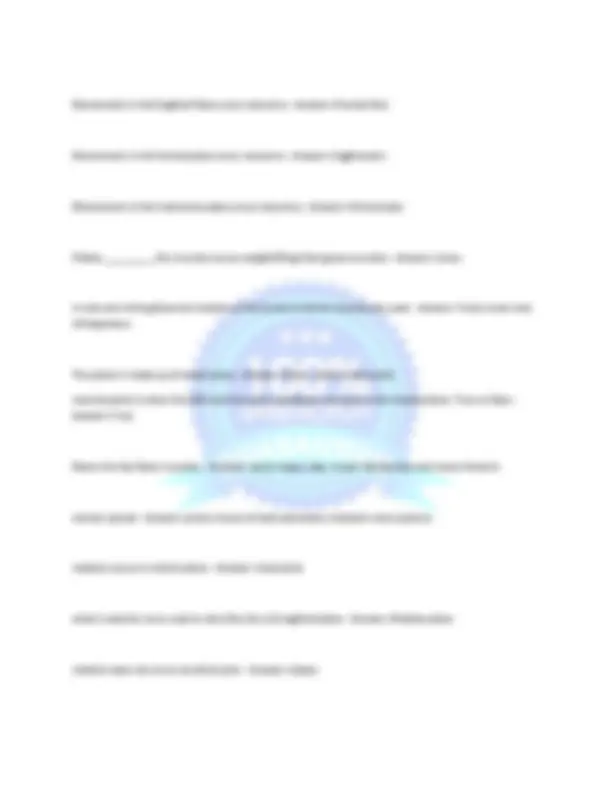
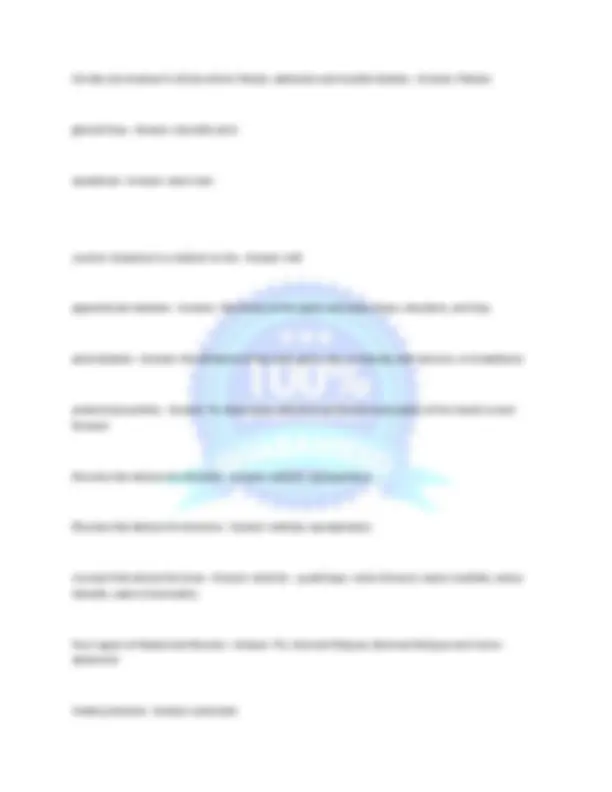
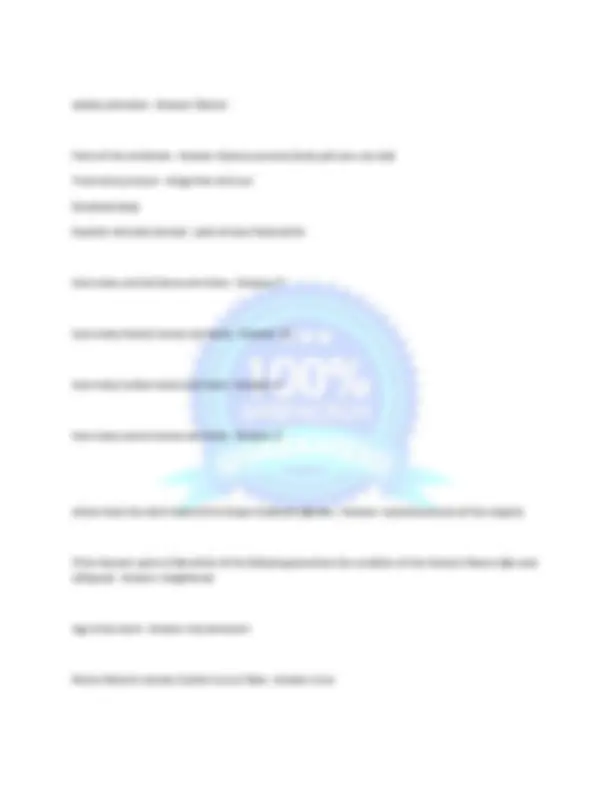
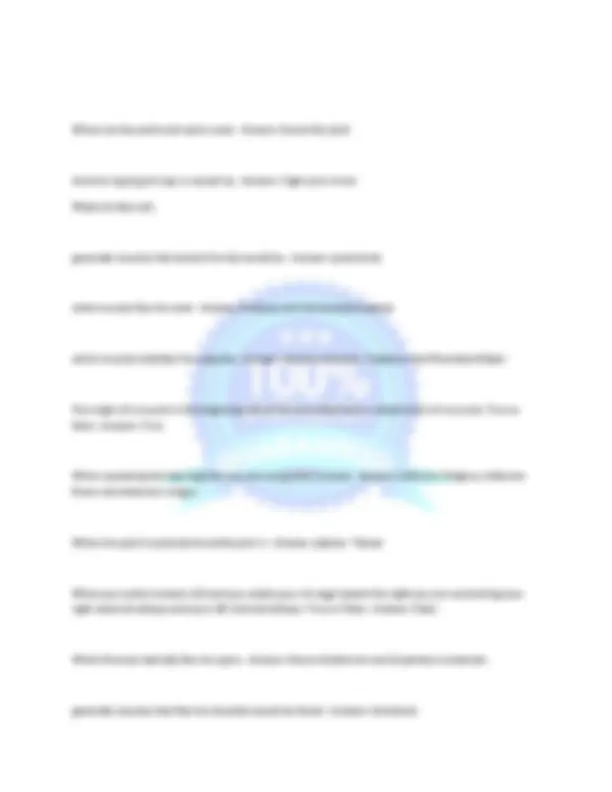



Study with the several resources on Docsity

Earn points by helping other students or get them with a premium plan


Prepare for your exams
Study with the several resources on Docsity

Earn points to download
Earn points by helping other students or get them with a premium plan
Community
Ask the community for help and clear up your study doubts
Discover the best universities in your country according to Docsity users
Free resources
Download our free guides on studying techniques, anxiety management strategies, and thesis advice from Docsity tutors
Which of the following does not represent how STOTT Pilates has evolved from Joseph Pilates original method? - Answer--Focus on more flat spine than original method What is another term used to describe mid-sagittal plane? A) Transverse B) Circuduction C) Frontal D) Medial Plan - Answer--D Rotation does not occur at which of the following joints: A) knee joint B) pelvis C) elbow joint D) spine - Answer--C Lordosis describes which of the following? A) An exaggerated curve in the lumbar spine B) A flat lumbar spine C) A hyper extended spine D)A flexed thoracic spine - Answer--A Lattisimus Dorsi is involved in all but which of the following? A) Extension B) Retraction C) Medially Rotates
Typology: Exams
1 / 24

This page cannot be seen from the preview
Don't miss anything!

















Which of the following does not represent how STOTT Pilates has evolved from Joseph Pilates original method? - Answer--Focus on more flat spine than original method
What is another term used to describe mid-sagittal plane?
A) Transverse
B) Circuduction
C) Frontal
D) Medial Plan - Answer--D
Rotation does not occur at which of the following joints:
A) knee joint
B) pelvis
C) elbow joint
D) spine - Answer--C
Lordosis describes which of the following?
A) An exaggerated curve in the lumbar spine
B) A flat lumbar spine
C) A hyper extended spine
D)A flexed thoracic spine - Answer--A
Lattisimus Dorsi is involved in all but which of the following?
A) Extension
B) Retraction
C) Medially Rotates
D) Flexion - Answer--D
Lattismus Dorsi assists in forced expiration?
A) True
B) False - Answer--A
Which muscle flexes the knee and extends the hip?
A) Rectus Femoris
B) Semimembranousous
C) Semitendinous
D Bicepts Femoris - Answer—D
If the thoracic spine is flat, which of the following is present?
Which muscle protracts the scapula?
A) Latissumus Dorsi
B) Serratus Anterior
C) Rhomboids
D) Mid Trapezius - Answer--B
Which joint involves the glenoid fossa?
A) Shoulder Joint
B) Knee Joint
C) Elbow Joint - Answer--A
What does contra-lateral mean?
A) same side of body
B) front side of body
C) opposite side of body - Answer--C
The scapula articulates which of the following?
A) Ribs
B) Clavicle
C) Spine - Answer--B
Which of the following is not one of the Joseph Pilates original principles?
A) Breathing
B) Precision
C) Scapular Placement
D) Control - Answer--C
Which bony landmark is on the femur?
C) Lesser Trochantor - Answer--C
Gluteus Max does not do which of the following?
A) medial rotate at the hip
B) laterally rotate at the hip
C) Extend at the hip - Answer--A
What is the action of the Serratus Posterior Superior?
A) Retracts the ribs during inspiration
B) Elevates the ribs during inspiration
C) Protracts the ribs during inspiration - Answer--B
C) Side Twist Kneeling
D) Long Box Arms Pulling Strap #1 - Answer--D
Rotation in a flexed postion only occurs at which of the following joint?
A) Hip joint
B) Elbow joint
C) Spine
D) Knee
E) Pelvis - Answer--B
The following joints rotate: Spine, Scapula, Pelvis, Knee
A) True
B) False - Answer—A
Frontal Plane Involves - Answer--1) lateral flexion
elevation
depression
upward and downward rotation
flexoin and extension of elbow
Abduction
Adduction
Transverse Plane involves - Answer--1) rotation
supination-forearm
pronation-forearm
protraction
retraction
Multiplanar involves - Answer--circumduction (shoulder joint/hip)
Exhalation promotes which of the following:
A) Spinal Flexion
B) Spinal Extension - Answer--A
The cervical spine has 7 vertebrae, Thoracis spine has 12 and Lumbar spine has 5?
A) True
B) False - Answer--A
The spine moves along with the following:
A) clavicle
B) pelvis
C) rib cage
D) shoulder - Answer--C
Hip Abductors - Answer--1) Gluteus Medius
Hip Abductors - Answer--1) Gluteus Medius
3)Sartorious
What involves the glenoid fossa? - Answer--Iposi lateral
Sagital plane involves - Answer--1) flexion
extension
anterior tilt
posterior tilt
plantar flexion
dorsiflexion
What are the muscle fibers doing during a concentric contraction?
A) Elongating
B) Shortening
C) Isometric - Answer--B
Which bony landmark is on the femur? - Answer--Greater Trochantar
Origin are typically
A) Distal
B) Proxial
C) Medial - Answer--B
Insertion are generally
A) Medial
B) Proxial
C) Distal - Answer--C
Axial of the skeleton is:
A) Arms, hands, feet
B) Hip, knee, feet
C) Head, spine, rib cage - Answer--C
Isotonic is taking place with normal contraction
A) True
B) False - Answer--A
Fixed joints are
A) Skull and teeth
B) fingers and feet
C) elbows and knee - Answer--A
Circular movement of arm and shoulder is multiplanar (is where we get the most movement)
A) True
B) False - Answer--A
Example of a facet joint:
A) Clavicle
B) Spine
C) Rib Cage - Answer--B
tensor fasciae latae origin and insertion - Answer--Origin: Anterior aspect of iliac crest and anterior superior iliac spine
Insertion: Iliotibial tract
Coracobrachialis Origin and insertion - Answer--O: Coracoid process
I: Middle medial humerus
Semitendinosus origin and insertion - Answer--O: ischial tuberosity, I: tibial shaft
Semimembranosus origin and insertion - Answer--O: ischial tuberosity
I: medial tibial condyle
Gracilis: Origin and insertion - Answer--O: body of pubis, I: medial tibia
Rhomboid Minor Origin and Insertion - Answer--O: ligamentum nuchae, SP C7 and T
I: medial border of scapula
transversus abdominis Origin and Insertion - Answer--Origin: inguinal ligament, lumbar fascia, cartilages of last 6 ribs / linea alba, pubic crest
Insertion: The linea alba by it's aponeurosis
pectoralis major Sternal Division -Origin and Insertion - Answer--O= Sternum to 7th rib, cartilages of the rib
I: Lateral lip of the humerus
Psoas major origin and insertion - Answer--O: bodies and transverse processes of lumbar vertebrae
I: lesser trochanter
Middle Deltoid Origin and Insertion - Answer--Origin: acromion process
Insertion: deltoid tuberosity
pectoralis major- Clavicular Division - Origin and Insertion - Answer--O: Anterior surface of the medial 1/2 of clavicle
Supraspinatus Origin and insertion - Answer--origin: supraspinous fossa of scapula
insertion: greater tubercle of humerus
Teresa Major Origin and Insertion - Answer--O: dorsal surface of inferior angle of the scapula
I: Medial lip of intertubercular sulcus of humerus
Soleus Origin and Insertion - Answer--O: proximal tibia, I: calcaneus
rhomboid major Origin and Insertion - Answer--O: Spinous processes of T2-T
I: Medial border of scapula from root of spine to inferior angle
brachioradialis Origin and Insertion - Answer--Origin: lateral supracondylar ridge of humerus
Insertion: styloid process of radius
levator scapulae Origin and Insertion - Answer--O: Transverse processes of C1-C
I: Medial border of scapula, above root of spine of scapula
gluteus medius - origin and insertion - Answer--O: ilium, I:greater trochanter of femur
gluteus minimus - origin and insertion - Answer--O: ilium, I:greater trochanter of femur
Trapezius - Origin and Insertion - Answer--O=occipital bone, C1-7, T1-12,; I= Acrominion and spinous process of scapula, clavicle
rectus femoris - Origin and Insertion - Answer--O: iliac spine and acetabulum, I:tibial tuberosity and patella
adductor longus Origin and Insertion - Answer--O: Pubic tubercle
I: Medial lip of linea aspera
Multifidus Origin and Insertion - Answer--O: deep to semispinalis, fibers pass obliquely and medially to spinous process, stabilizes vertebrae
origin:sacrum, lumbar, thoracic vertebrae
insertion: base of spinous processes of all vertebrae from L5 to C
Vastus Lateralis Origin and Insertion - Answer--O= greater trochanter, linea apsera, I: tibial tuberosity and patella
Vastus Medialis Origin and Insertion - Answer--O: linea aspera and intertrochanteric line, I: tibial tuberosity and patella
Rectus Abdominis Origin and Insertion - Answer--origin :of rectus abdomens is the pubis
nsertion 5-7 ribs and xiphoid process
Iliac Origin and Insertion - Answer--Origin: Inner lip of iliac crest
Medial head: inferior 2/3 on the posterior surface of the humerus
Insertion: Supraposterior surface of the olecranon process of the ulna and deep fascia of the forearm
Latisumus Dorsi Origin and Insertion - Answer--Origin: Broad aponeurosis that originates on the spinous processes of lower 6 thoracic and all lumbar vertebrae, posterior crest of ilia, posterior surface of sacrum, lower 3 or 4 ribs and an attachment to the inferior angle of the scapula
Insertion: Flat tendon that twists upon itself to insert into the intertubrcular sulcus of the humerus
Peroneus Longus and Peroneus Brevis Origin and Insertion - Answer--O: fibula
I: metatarsal
Plantaris Orign and Insertion - Answer--O: femur
I: Calcaneus
subscapularis Origin and Insertion - Answer--origin: subscapular fossa
insertion: lesser tubercle of humerus
Internal intercostals Origin and Insertion - Answer--Origin: Superior border of rib below
Insertion: Inferior border of rib above
Lower Trapezius Origin and Insertion - Answer--O- spinous process of T6-T
I- Medial end of spine of the scapula
Movements in the Sagittal Plane occur around a - Answer--Frontal Axis
Movements in the frontal plane occur around a - Answer--Sagittal axis
Movements in the transverse plane occur around a - Answer--Vertical axis
Pilates _________ the muscles versus weightlifting that grows muscles - Answer--tones
In side arm sitting External rotation of the humerus which muscles are used - Answer--Teres minor and infraspinatus
The pelvis is made up of what bones - Answer--Illium, ischium and pubis
neutral pelvis is when the ASIS and the pubic symphysis are level in the frontal plane. True or false - Answer--True
Name the hip flexor muscles. - Answer--posts major, iliac, tensor fasciae late and rectus femoris
erector spinae - Answer--prime mover of back extension; maintain erect posture
rotation occurs in which plane - Answer--transverse
what is another term used to describe the mid-sagittal plane - Answer--Median plane
rotation does not occur at which joint - Answer--elbow